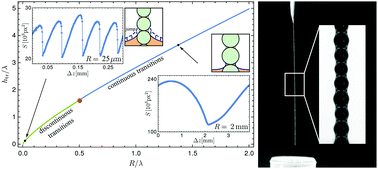Continuous and discontinuous transitions between two types of capillary bridges on a beaded chain pulled out from a liquid†
Abstract
Capillary bridges can be used for fabricating new materials and structures. Here, we describe theoretically and validate experimentally the mechanism of formation of capillary bridges during a process in which a beaded chain is being pulled out from a liquid with a planar surface. There are two types of capillary bridges present in this system, namely the sphere–planar liquid surface bridge initially formed between the spherical bead leaving the liquid bath and the initially planar liquid surface, and the sphere–sphere capillary bridge formed between neighbouring beads in the part of the chain above the liquid surface. During the process of pulling the chain out of the liquid, the sphere–planar liquid surface bridge transforms into the sphere–sphere bridge. We show that for monodisperse spherical beads comprising the chain, this transition can be either continuous or discontinuous. The transition is continuous when the diameter of the spherical beads is larger than the capillary length. Otherwise, the transition is discontinuous, likewise the capillary force acting on the chain.



 Please wait while we load your content...
Please wait while we load your content...